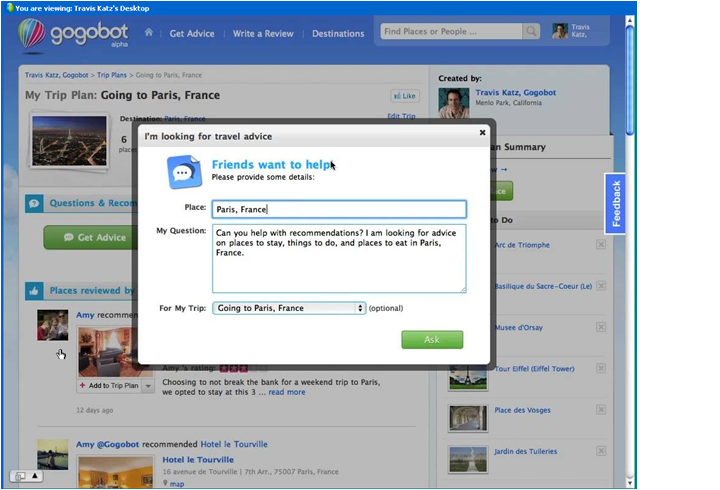Gogobot Leverages Social To Enhance Travel
Forrester estimates that in 2010, $80 billion of leisure and personal travel will be bought online – an amount that will increase to $110.7 billion by the end of 2014. Our research also shows that more than 7 in 10 online leisure travelers in the US use social media. Naturally, we’re seeing many firms begin to offer social trip planning solutions. The latest group looking to make a run at the prize is “Gogobot,” a self-described “social recommendation platform for travel” scheduled to launch in beta test on Tuesday, November 16.
Gogobot recently briefed Forrester. In opening up the conversation, Gogobot’s CEO Travis Katz (a MySpace alumnus) stated that “friends, not strangers” are what help to make a trip enjoyable. Hokey, but he has a point: we value advice from people we know. Gogobot allows us to leverage not only the wisdom of the crowd, but also our existing social networks in order help with the discovery and inspiration we value, but is often lacking from most mainstream travel sites, including those belonging to major online travel agencies and travel suppliers.
The key to Gogobot is its ability to help a user find not just advice and content, but relevant advice and content. Gogobot users can sign in via their Facebook account – making Gogobot convenient – and discover which of their friends have recommended a particular restaurant or hotel in one of thousands of locations. Yes, I know –pass the popcorn, we’ve seen this movie before. Where Gogobot’s true benefit becomes apparent is the control it extends to its users.
But before we get to Gogobot’s approach, think about how you travel. Like the character Sybil, who suffered from multiple personality disorder, each of us has a different “personality” when we take a trip. For example, the way you’d travel on a two-night business trip to a city you regularly visit will be different than when you make a week-long business trip to the other side of the world. As for personal travel – well, for how long, and to where? Will you be traveling solo, with your spouse or partner or some friends? Will kids be in tow? The personal side of travel is extremely complex and multi-dimensional. The key to a successful trip lies just as much by successfully addressing the subtleties of the journey as the big obvious things, like transportation and accommodation.
Back to Gogobot: How will they be useful to travelers, and distinguish themselves in an already crowded marketplace? Gogobot’s secret sauce lies in the “tribes” which Mr. Katz says will “use the wisdom of the [social] graph to divide your friends into groups.”

The idea behind the “tribe” is that when a user asks for recommendations on a destination, hotel, activity, or restaurant, she can choose to target her request to selected friends whose experiences or tastes may be more closely aligned to hers. A user can also ask the entire Gogobot community or her Facebook friends, since Gogobot can be integrated with the user’s Facebook account. For example, if I’m looking to take a client in Paris to dinner, I can target my request to friends who live in or have recently visited the City of Lights on business and entertained a client there. If I were to take my nephews and niece to Paris, I could ask everyone on Gogobot, all of my friends on the site, or just my friends who live in or have visited Paris with kids around the same ages as my nephews and niece. I can then save everything into a trip plan – which I can in turn save as a .PDF, print out, or view from a Smartphone device. This flexibility and organization within a user’s social graph is Gogobot’s best chance to succeed in this packed yet lucrative market.
Gogobot’s challenge will be to create a critical mass large enough to take advantage of its unique platform (see screenshot below). Consumers already have plenty of social trip planning tools available, including Voyavo, Tripadvisor’s Facebook integration and, of course, Facebook’s own “ask a question,” so it’s not like there’s a vacuum of choices. And oh yes, we can also email or text our friends – and some of us still use that old-fashioned device called the phone (cell or landline) to actually talk to the people we know (I know, how old school). Gogobot absolutely needs to distinguish itself from the pack while also generating enough interest to build its recommendation-based content into something worth searching for.

Will Gogobot make it? We think they have a good chance, though it won’t be easy. For one, other sites – especially TripAdvisor – have already entered this space with very solid offerings. Gogobot has a strong top team – its CTO, Ori Zaltzman hails from Yahoo, where he was Engineering Manager on Yahoo Answers and was Chief Architect for Yahoo BOSS – and they secured a $4 million investment from Battery Ventures. Gogobot can work as a standalone site, but we see potential for the company to license its application to larger travel sellers to help them enhance their social networking capabilities. We’re not convinced – yet – that Gogobot is a barn-burner of a site, or the most innovative. But, Gogobot is clever, relevant, and useful, and a site we believe is poised for success.